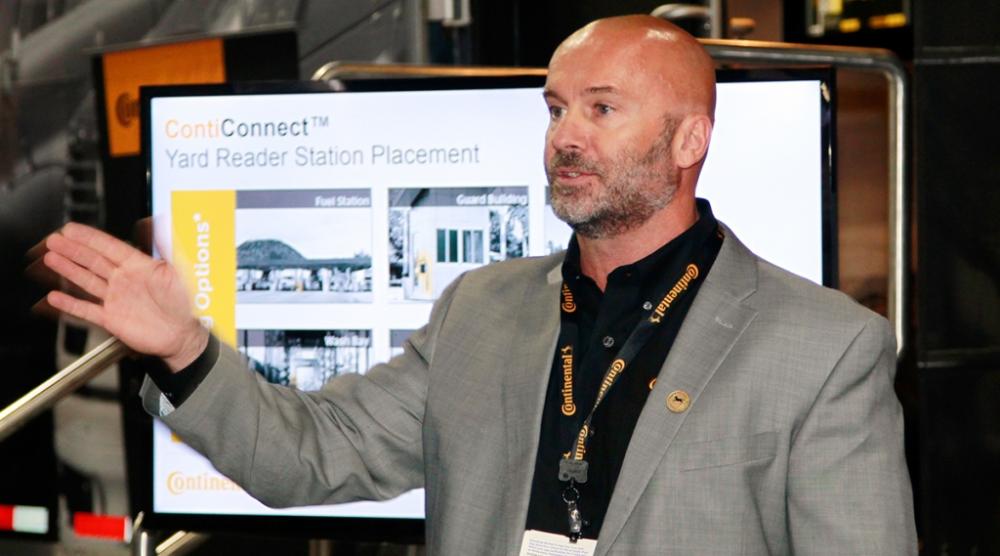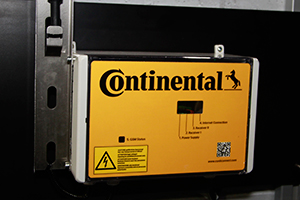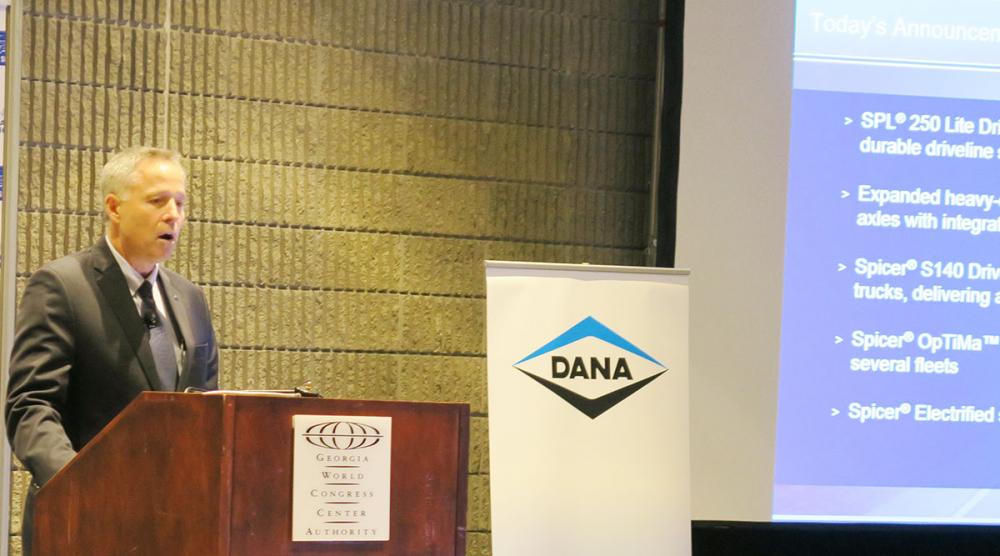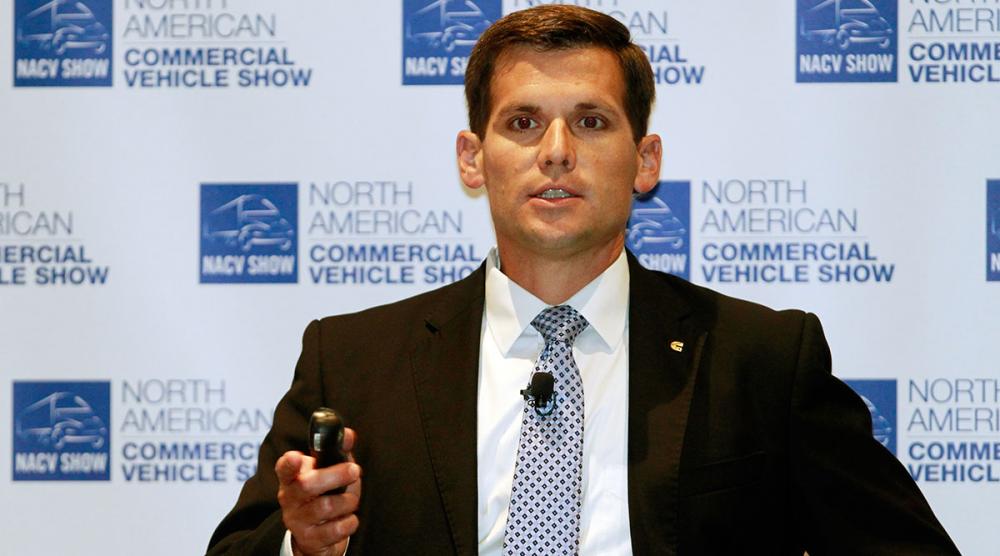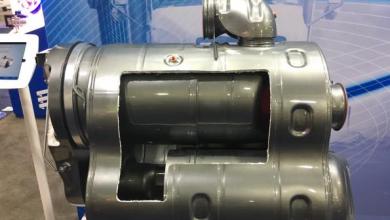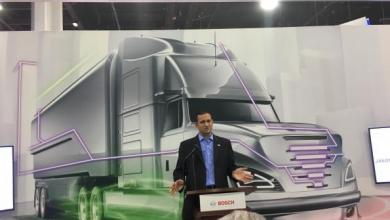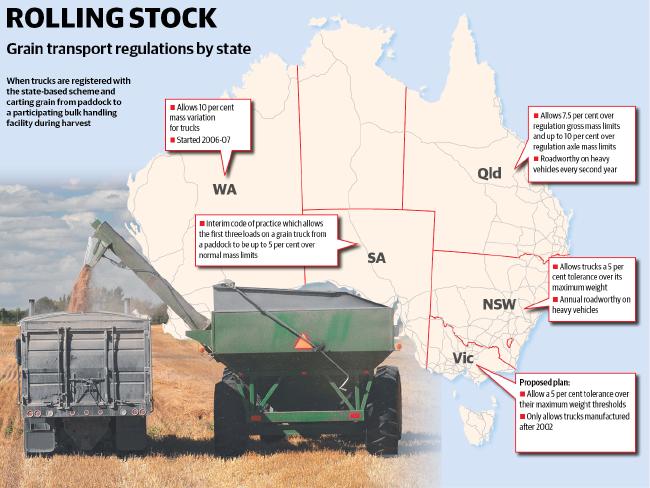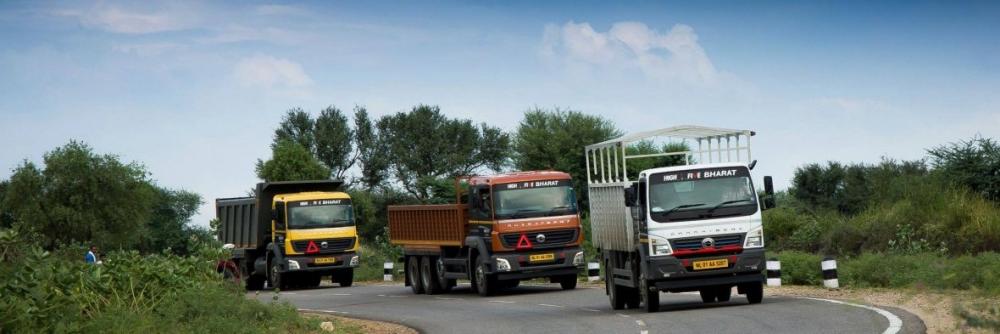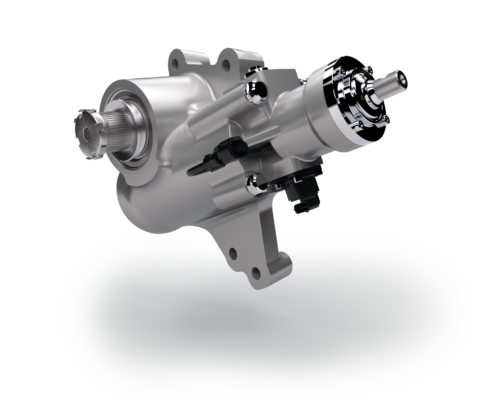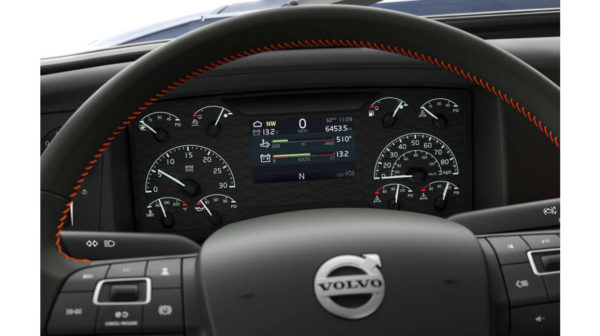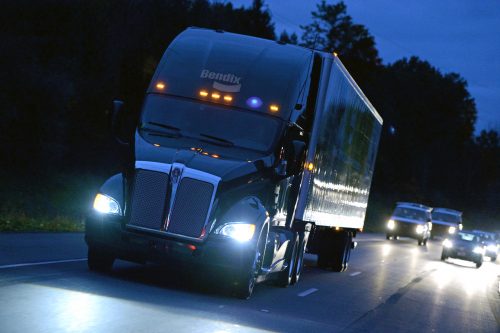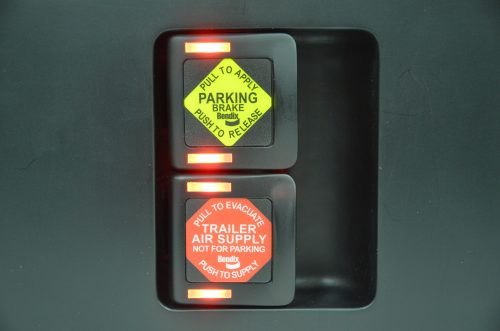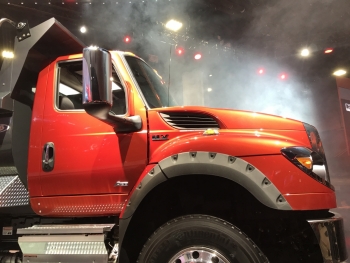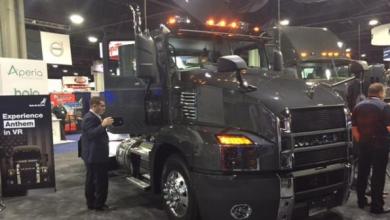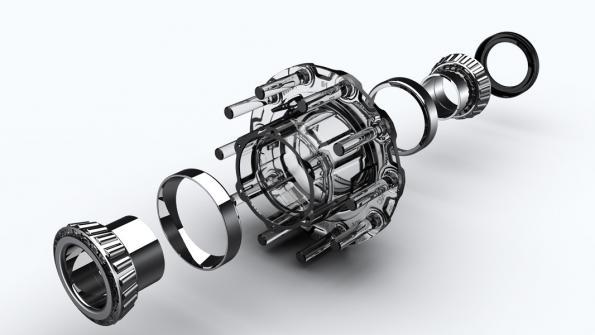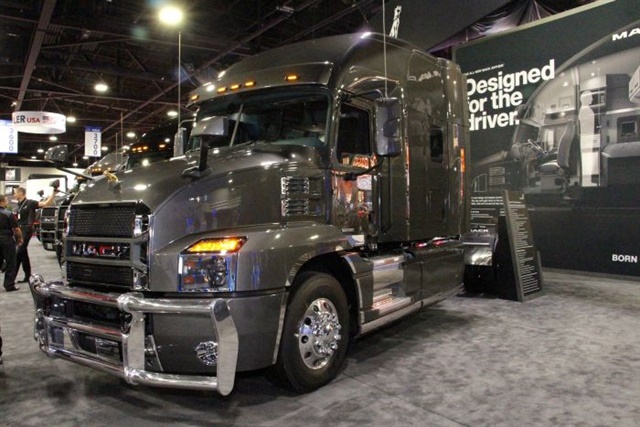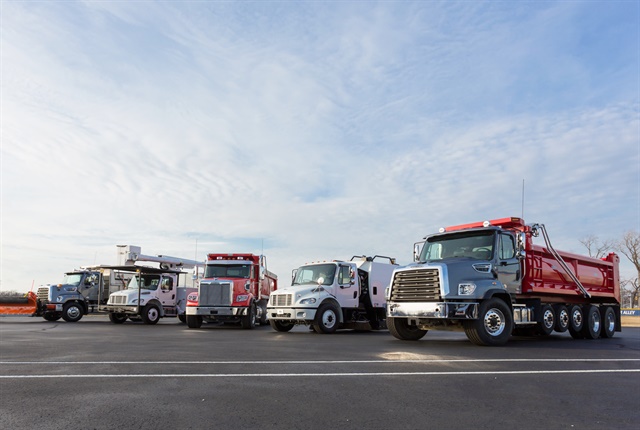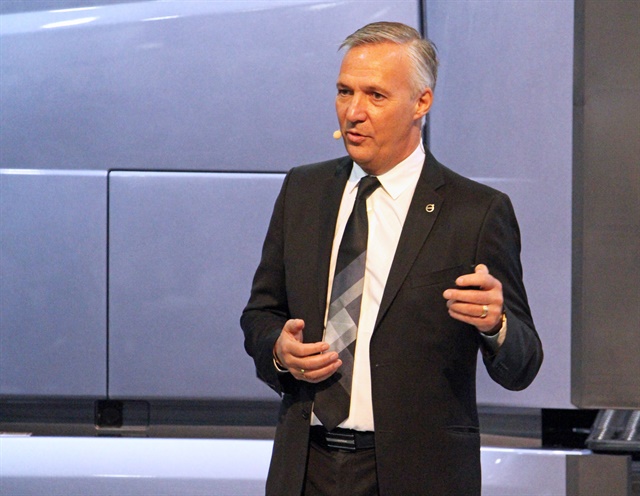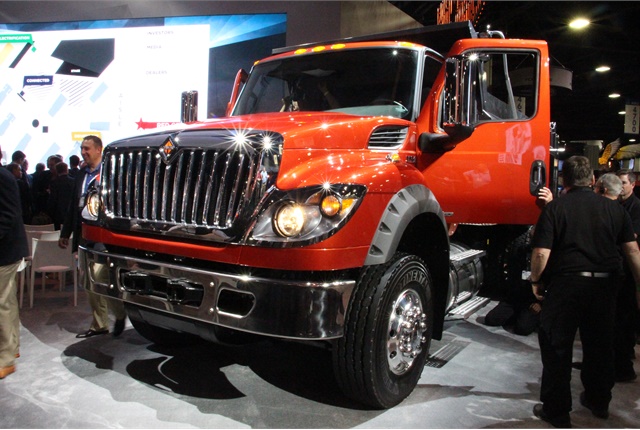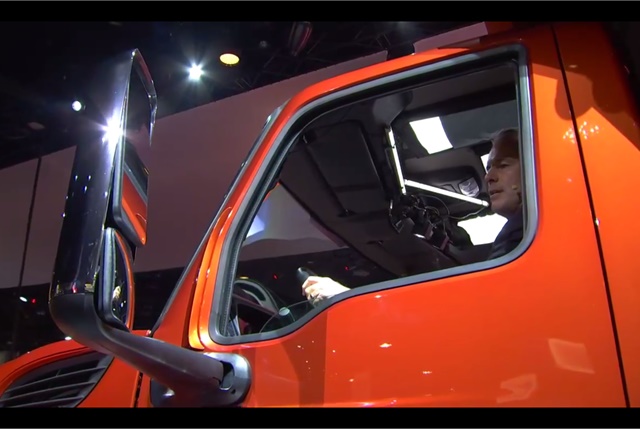
kscarbel2
Moderator-
Posts
17,893 -
Joined
-
Days Won
86
Content Type
Profiles
Forums
Gallery
Events
Blogs
BMT Wiki
Collections
Store
Everything posted by kscarbel2
-
Transport Topics / September 26, 2017 ATLANTA — Continental Tire has introduced a system that checks inflation levels in a truck’s tires as it passes an external monitoring station, with data transmitted from sensors integrated into the tires that require no electronics to be installed on the truck, the company said. The system, called ContiConnect, is designed for “anybody who is coming and going through a terminal on a regular basis,” said Paul Williams, executive vice president for the company’s North American tire operations. This could include, he said, transit or school buses, dump trucks and more. Sensors installed in the inner lining of the tire measure tire temperature and inflation. Mounting the sensors in the tire rather than on the rim helps prevent false readings due to heat being generated by the truck’s braking system, Williams said. The system does not require a telematics system on the truck, he noted. As trucks enter a fleet yard, terminal or other location where the company’s “yard reader” data station is installed, the station picks up readings from the sensors and transmits them to the ContiConnect web portal via a cellular network. The data from there can be read by a maintenance manager or other company representative, who can take corrective action that might prevent a tire failure on the road, Williams said. The system issues low pressure alerts and tracks data over time, and permits users to view reports and analytics for all tires equipped with sensors. The platform also features customizable text and email notifications, so the fleet personnel can receive immediate alerts when low tire pressure or high tire temperature is recorded. “You have to get the data outside of the truck to someone who cares,” he said. Select tire models are available direct from the factory with sensors installed. Sensors can also be installed into a fleet’s existing tires, Continental said. The sensors can also be installed in retreads, Williams added. Continental also offers its ContiPressureCheck system for fleets interested in seeing real-time tire data via a telematics system. This system offers data integration with multiple telematics providers, including Zonar, which is majority owned by Continental, as well as PeopleNet. This integration allows tire data to be seen in both the providers’ in-cab displays and back-end portals, Continental said. .
-
Dana launches SPL 250 Lite driveshaft for heavy trucks
kscarbel2 replied to kscarbel2's topic in Trucking News
Dana Introduces New Driveshaft Product and Medium-Duty Option Transport Topics / September 26, 2017 ATLANTA — Dana Inc. launched its latest driveshaft, expanded the availability of a drive axle and offered a new option for certain steer axles, while outlining the trends in electrification. The company made its announcements at the inaugural North American Commercial Vehicle Show here Sept. 26. Ryan Laskey, vice president of engineering for commercial vehicle and core driveline products at Dana, outlined trends in the fast-emerging electrification of vehicles. First, battery costs are falling fast, he said. In 2010, the cost per kilowatt hour was about $1,000. “We see by 2020, they are going to sitting down in the range of $100 to $150 per kilowatt hour, and that is the point you really see total cost of ownership driving electrified solutions,” Laskey said. Regulations — both national and local — that slash emissions are the other key mega trend, he said. “You are going to need to have a solution that is not going to use the likes of a diesel engine to do that.” For its part, Dana is accelerating the hybridization of electrification across its entire driveline industry and power technologies group, he said. At the same time, the annual demand in China for “pure battery electric solutions” transit buses is already dwarfing electrification in the rest of the world, and is helping provide scale for companies involved in China and also looking to market in other areas, he said. China is on track for 100,000 such buses this year, and 300,000 in 2020, Laskey said. Meanwhile, Dana launched its SPL 250 Lite driveshaft, calling it the next generation in a “robust” series of driveshafts for heavy-duty trucks. It is designed to handle torque ratings up to 25,000 Nm [newton-meter], and is up to 25 pounds lighter than competitive products and engineered to reduce noise, vibration and harshness levels, according to the company. “The lower numeric axle ratios required to support engine downspeeding and improve fuel efficiency can cause significant stress to the drivetrain and alter harmonics in driveline components,” Mark Wallace, president of Dana Commercial Driveline Technologies, said in a statement. In addition, Dana’s Spicer S140 Series single-reduction, single-drive axle is now available as an option on Classes 6 and 7 vehicles from Peterbilt Motors Co. — a unit of Paccar Inc. — including the 220, 330, 337 and 348 models. It comes with gross axle weight ratings from 17,000 through 21,000 pounds, while weighing up to 100 pounds less than competitive axles, according to Dana. With 50% fewer components and six fewer pints of lubricant required than any other axle in its class, maintenance costs have also been reduced, according to the company. Both the SPL 250 Lite and SPL 350 Lite driveshafts are available with a choice of service-free or standard re-lube designs to accommodate fleet preference. Lastly, Dana made its new aluminum hub an option on Spicer D-Series steer axles with a 14,600-pound gross axle weight rating, according to the company. Dana supports the commercial truck, off-highway and passenger vehicle markets, as well as industrial and stationary equipment applications. . -
Transport Topics / September 26, 2017 ATLANTA — Cummins Inc. is looking at how to expand its medium-duty powertrain market into Classes 4 and 5, eventually, a company executive said. “We continue to look at it, what the right powertrain is. I think you’ll see over the next few years how we enter that [Classes 4 and 5] market. We do have interest. We just need to figure out how to attack it,” said Brett Merritt, general manager, on-highway engine business, at Cummins. Transport Topics interviewed Merritt during the inaugural North American Commercial Vehicle Show here Sept. 25. The question is how do you “get the cost-effective solution that still meets the need of that market, and then have a partner that can cost-effectively compete on the truck side,” Merritt said. In the meantime, Cummins has moved from a single percentage point market share in medium-duty in the early 2000s to now a leading 76%, “depending on what part of the market you calculate,” he said. Cummins calculates it as Classes 6 and 7, as well as Class 8, Group 1 — “that’s a 9-liter engine,” he said. “The medium-duty is a great market, and it kind of surprised a few of us. It has been a steady market, but at some point you thought it may not continue to grow, but it continues to be a strong market,” Merritt said. .
-
Neil Abt, September 27, 2017 ATLANTA. Eberspaecher introduced its next generation 1Box aftertreatment system at the North American Commercial Vehicle show this week. The shape of the 1Box helps reduce weight by about 40% over other box style solutions, said Dale Boone, director of product development of commercial vehicle business for the Americas. He added the 1Box aftertreatment system integrates the diesel oxidation catalyst, diesel particulate filter and selective catalytic reduction into one package. Also at NACV, Eberspaecher introduced its new 1Line aftertreatment solution, which combines the DPF and SCR into a single component. In addition, it showed the new compact mixer, which is engineered to work with all urea injector designs and styles. .
-
Bosch turns the truck into a technology showcase Neil Abt, September 26, 2017 ATLANTA. Bosch used its booth at the North American Commercial Vehicle show to demonstrate its vision of turning a truck into what Jason Roycht, vice president of the commercial vehicle unit, called “a technology showpiece.” Roycht said through the combination of automation, connectivity, and electrified technology, lives will be saved and vehicle efficiency will increase. “The rate of change the next 10 years will be greater than the last 100,” he said during a Sept. 26 media briefing. “Connectivity is a part of our everyday lives. The commercial truck is no exception.” During that event, Bosch debuted a 15-inch freely programmable digital cluster, which it said is the largest available for the commercial vehicle industry. The company said the screen creates stunning clarity for the safe display of relevant information and enables future safety and automated solutions as it is integrated with advanced driver assistance technologies. The monitor has two variants, one in landscape mode as a dashboard solution and another in portrait mode as part of a mirror camera system that can replace side mirrors. To compliment the technology, Bosch also showcased its Central Gateway (CGW) that enables secure connectivity and acts as a router for in-vehicle communication. Bosch units ETAS and ESCRYPT provide the necessary transmission and encryption technologies that ensure data security. During the media briefing, Roycht also touched upon the recent announcement that it was partnering with Nikola Motor Co. in the development of the Nikola One and Two, a class 8 hydrogen-electric truck lineup. Roycht said Bosch’s eAxle expertise has allowed Nikola to move quickly on an aggressive path to bring its electric truck to market. The eAxle is a scalable, modular platform with the motor, power electronics, and transmission in one compact unit. This makes it suitable for vehicles of all kinds, from small passenger cars to light trucks The eAxles will be paired with a custom-designed fuel cell system – also being developed jointly between Nikola and Bosch. “Together with Nikola we are pushing ourselves to realize new levels of technological achievement and market penetration,” Dr. Markus Heyn, member of the Bosch board of management responsible for commercial vehicles. .
-
Green Car Congress / September 27, 2017 At the North American Commercial Vehicle Show (NACV) in Atlanta this week, Bosch is showcasing its portfolio of automated, connected and electrified technologies for commercial vehicles. At NACV, Bosch will debut its 15-inch freely programmable cluster, the largest digital cluster available for the commercial vehicle industry. The optically-bonded display enables future safety and automated solutions as it is easily integrated with advanced driver assistance technologies. Bosch’s 15-inch monitor has two variants, one in landscape mode as a dashboard solution and another in portrait mode as part of a mirror camera system that can replace side mirrors and improve vehicle efficiency by reducing drag. The Bosch Central Gateway (CGW) enables secure connectivity in commercial vehicles. It is the central communication node that acts as a router for in-vehicle communication and through the connectivity control unit (CCU) to the outside. It is the gate for all data coming into the vehicle and is secure through security functions such as firewall and intrusion detection. ETAS and ESCRYPT (both parts of the Bosch Group) provide the necessary transmission and encryption technologies that ensure functional safety and data security. Powertrain concepts. At NACV 2017, Bosch is also showcasing several future-focused powertrain concepts engineered to save fuel and money while extending the lives of fleets. The eCity Truck is an innovative diesel hybrid system that is a flexible and scalable solution allowing easy integration of an electric axle (eAxle) into light commercial vehicles to enable the easy conversion of a traditional diesel truck platform to a diesel-electric hybrid truck. The eAxle is a scalable, modular platform with the motor, power electronics, and transmission form one compact unit. To further reduce fuel consumption, the eCity Truck platform can also integrate 48-volt technology. The Bosch boost recuperation system enables the provision of a 48V electrical accessories as well as energy recovery and smooth, efficient functions such as start-stop. Bosch is also developing deeply integrated systems for the future that will offer greater fuel savings. The USDepartment of Energy (DOE) awarded a team led by Bosch up to $5 million dedicated to the development and demonstration of a commercially-viable, plug-in hybrid electric vehicle (PHEV) powertrain for medium-duty vehicles typically used in delivery vehicle fleets as part of the Medium-duty Urban Range Connected Extended Powertrain (MURECP) project. At NACV, Bosch will present progress to-date on the project as part of a comprehensive view of the future of the commercial vehicle powertrain. Progress on the MURECP project includes the advanced dual-planetary gear transmission (e2PG) featuring multiple clutches that reduces fuel consumption by more than 50% on a real-world drive cycle. The design calls for a scalable battery that makes an all-electric driving range feasible, enabling zero local emissions driving in city centers. Targeting CV delivery trucks, the e2PG powersplit/multi-mode transmission architecture allows for an efficient downsizing of an internal combustion engine via deep integration of two electric motors, resulting in reduced fuel consumption while still maintaining or even improving the overall performance of the vehicle. Control unit. The Bosch vehicle control unit (VCU) for Commercial Vehicle and Off-road vehicle application enables the development of future technologies, not only for powertrain diversification, but also for automated driving functionalities as well as connected functionalities. The VCU offers one scalable electric/electronic (E/E) architecture to handle the increased number of calculation-intensive and cross-domain functionalities within continuously evolving efficient, connected and autonomous vehicle. Thermal management. Whether a traditional internal combustion engine, hybrid-electric or electric vehicle, thermal management has emerged as a key topic for managing vehicle efficiency. At NACV, Bosch will demonstrate technologies it has developed to manage heating and cooling vehicles. Bosch is working to efficiently manage the heat flow and avoid wasting energy, ultimately improving fuel efficiency of internal combustion engines or increasing the range of electric and hybrid-electric vehicles. The example thermal system will show Bosch fans, pumps and valves for optimizing energy management throughout the entire vehicle—including solutions for highly efficient heating and air conditioning that satisfies all comfort needs. Actuator. The innovative Electronically Commutated Actuator (ECA) is a Bosch brushless direct current (BLDC) electric motor platform designed specifically for actuation tasks in commercial vehicle applications and environments. Newly designed from the ground up, the ECA actuator performs very precise and high dynamic actuation tasks in the rough environments of engine compartments, chassis and powertrain applications. ADAS. Bosch’s driver assistance systems actively support the driver to enhance driving comfort and improve safety on the path to automated driving. Bosch has an expansive catalogue in this space, including ultrasonic, radar and video sensors as well as steering solutions. The latest generation of the Bosch multi-purpose camera (MPC) is a scalable, monocular camera platform for video-based driver assistance systems that make driving safe and more comfortable. The MPC integrates a wide range of driver assistance functions into vehicles using only one sensor. Another key enabler for driver assistance technology is the Servotwin steering system, a steering technology pre-requisite needed for automated driving. The Servotwin enables automatic steering for functions such as lane-keeping assistance and cross-wind compensation. The Bosch demonstration truck will feature how the Servotwin and multi-purpose camera work together in lane-keeping functions.
-
Green Car Congress / September 27, 2017 Volvo Trucks is taking the position that by replacing diesel with liquefied natural gas or biogas, CO2 emissions from heavy trucks can be drastically reduced. Volvo Trucks is intensifying its development of gas-powered trucks for heavy regional and long-haul operations. Reducing climate-impacting emissions from heavy commercial traffic is a challenge that engages politicians and transport purchasers, haulage companies and vehicle manufacturers. In May the EU presented a regulation demanding declaration of CO2 figures from heavy vehicles as of 2019, with the aim of reducing CO2 emissions. Many of our customers and their customers already work hard to reduce their environmental footprint. This regulation will drive the development of lower emissions, where we see a clear possibility for increasing LNG market shares as a vital part of the solution. Our vision is that trucks from Volvo will eventually have zero emissions, although the way of achieving that is not by one single solution but rather through several solutions in parallel. —Lars Mårtensson, Director Environment and Innovation at Volvo Trucks Although a fossil fuel, natural gas can produce 20% lower CO2 emissions than diesel. If biogas is used instead, the climate impact can be cut by up to 100%. While biogas is thus far only produced in limited quantities, the long-term availability of natural gas is excellent in a global perspective. This is an important condition for large-scale expansion, as is a competitive price, Volvo says. In many European countries, natural gas costs less than diesel. A strategy for expanding LNG infrastructure is also included in the European Commission’s and member states’ action packages for securing Europe’s long-term energy supply. All told, this makes liquefied gas the best widely available climate alternative on the market for long and heavy transports. What is needed now is gas-powered trucks that can compete with diesel in terms of performance and fuel consumption, and continued expansion of LNG infrastructure. In both cases major progress has been achieved. —Lars Mårtensson
-
Meritor Announces New Products, New Brand and Redesigned Components
kscarbel2 replied to kscarbel2's topic in Trucking News
Meritor developing electric solutions platform for commercial vehicles Green Car Congress / September 27, 2017 Meritor is developing a platform of electric drive axles and suspensions as well as supporting systems to position Meritor as a leader in electric solutions for the commercial vehicle market. “Essentially, we’re focusing on integrating an electric motor into the differential carrier,” said Jay Craig, CEO and president for Meritor. “As we look to future emissions regulations and our customers’ desire for more efficiency, we’re developing new and innovative solutions to expand our product portfolio.” Meritor’s flexible e-carrier design will be the foundation for various drivetrain configurations, including full electric, hybrid, single or tandem axles with various options based on application, according to Craig. Designed for city-delivery, medium-duty and transit bus, as well as off-road and severe-duty applications, the electrified, lightweight carrier offers several benefits over remote-mounted electric motor configurations. Meritor designed the e-carrier as a drop-in replacement of a conventional mechanical carrier that does not disrupt axle or suspension packaging. Because the electric motor is integrated into the axle, space is freed up for batteries and other electrical components, offering easier packaging and installation and a safer, more protected location inside the frame rails to mount the batteries. The solution also eliminates cost and weight associated with a driveline and mounting a remote motor with brackets. The following near-term electrified product solutions are under development by Meritor: · Integrated two-speed electric carrier platform capable of delivering 150-200 kilowatts of continuous power for mounting on existing axle platforms, fitting a wide variety of applications on rigid and independent suspensions. · 13Xe rigid axle, capable of 200 kW of continuous power and featuring customizable gearing to cover linehaul, school bus, refuse, pickup and delivery, utility and other applications. · Electric-driving independent suspension for applications such as military, emergency, off-highway and construction vehicles that will benefit from increased performance as well as better ride comfort and handling. · Electric eCorner module for low-floor applications such as medium-duty Classes 4 and 5, pickup and delivery and transit buses. Meritor will also offer braking systems optimized for e-axles. The Next Generation Quadraulic brake and Next Generation Air Disc Brake have been designed for use on hybrid or electric vehicles with regenerative braking. Both brakes reduce weight on wheel-ends, according to Craig. Each of these product solutions focuses on increased fuel economy and efficient performance as well as drivability, emphasizing on-demand torque response of the electric motors. The components will be part of a demonstration vehicle to be built in 2018, with production beginning as early as 2019. -
NAFTA negotiators make progress, but say a lot of work remains Reuters / September 27, 2017 OTTAWA -- The United States, Canada, and Mexico said on Tuesday they had made some progress in talks to modernize the NAFTA trade pact while acknowledging much work remained if they are to wrap the process up by the end of the year, as planned. Negotiators ended the third of seven rounds in Ottawa by saying they had substantially concluded one chapter, on small- and medium-sized enterprises. They also said they expected to wrap up work on competition issues before the next round in Washington from Oct 11-15. But the three teams did not dive into the details of the most sensitive matters and Mexican Economy Minister Ildefonso Guajardo told a news conference that there would be "substantial challenges" in the next round. Mexican and Canadian officials have already expressed concern that the United States has not yet presented details on some of the toughest issues, such as rules of origin which outlines how much of a product needs to originate in a NAFTA country. The talks are supposed to finish in December but trade experts say this is unlikely, given the complexity of some of the most contentious topics. "We never said this was going to be easy," Canadian Foreign Minister Chrystia Freeland told reporters at the end of the five-day session. Trade among the three nations has quadrupled since NAFTA came into effect in 1994, surpassing $1 trillion in 2015. But U.S. President Donald Trump regularly calls the treaty a disaster and has threatened to walk away from it unless major changes are made, citing U.S. job losses and a trade deficit with Mexico. The talks took place as Canada fumed over a U.S. decision to impose preliminary duties on Bombardier's CSeries jets, which is likely to add to trade tensions. The decision by the U.S. Commerce Department is likely to further harden Canada's stance on keeping a key dispute-settlement mechanism in the NAFTA, which the Trump administration wants to eliminate. Freeland raised the issue with U.S. Trade Representative Robert Lighthizer on Wednesday during NAFTA negotiations, Prime Minister Justin Trudeau told legislators. Freeland has suggested that Canada could walk away from the NAFTA talks over the so-called Chapter 19 dispute mechanism, under which binational panels make binding decisions on complaints about illegal subsidies and dumping. The United States has frequently lost such cases. A lengthy fight over Chapter 19 could drag out NAFTA negotiations beyond a planned end-December deadline to reach a deal ahead of Mexico's presidential election campaign. The U.S. delegation presented draft text on NAFTA labor standards on Tuesday and put forward proposals on investment and intellectual property at the weekend. Laxer labor standards and lower pay in Mexico have swelled corporate profits at the expense of Canadian and U.S. workers, making the issue one of the major battlegrounds of the NAFTA talks.
-
FCA to engage in settlement talks over diesel emissions Reuters / September 27, 2017 WASHINGTON -- Fiat Chrysler Automobiles next month will engage in settlement talks with lawyers representing vehicle owners suing the automaker over excess diesel emissions, a court-appointed settlement adviser said Wednesday. The talks are set for Oct. 12 in Washington. In May, the U.S. Justice Department sued Fiat Chrysler, accusing the company of illegally using software that led to excess emissions in nearly 104,000 U.S. diesel vehicles sold since 2014. It also faces numerous lawsuits from owners of those vehicles. German auto supplier Robert Bosch GmbH, which develops diesel vehicle systems, has also been sued by U.S. vehicle owners and will take part in the settlement talks next month, settlement master Ken Feinberg said in court. The government will not participate in the talks, Feinberg said. In July, FCA won approval from federal and California regulators to sell 2017 diesel vehicles after it came under scrutiny for alleged excess emissions in older diesel models. An FCA lawyer, Robert Giuffra, said in court the company was confident of being able to use updated emissions software in the 2017 vehicles as the basis of a fix to address agencies’ concerns over 2014-2016 Fiat Chrysler diesel vehicles. Giuffra said the engine and emissions controls were identical in the older vehicles to those in the 2017 models. Justice Department lawyer Leigh Rende said the federal government and California were near agreement on a testing plan with the company to see if the fix will work. The government and company must obtain representative vehicles to test as well, she said. Regulators have said that the older Fiat Chrysler diesel vehicles had undisclosed emissions controls that allowed vehicles to emit excess pollution during normal driving. The company has denied wrongdoing, saying there was never an attempt to create software to cheat emissions rules. Fiat Chrysler's emissions case came after Volkswagen AG's diesel emissions scandal prompted increased industry scrutiny. The German automaker pleaded guilty in March to having intentionally cheated on emissions tests for vehicles it sold since 2009 VW has agreed to spend up to $25 billion to address claims from U.S. owners, environmental regulators, states and dealers, and offered to buy back about 500,000 polluting U.S. vehicles. Regulators are also investigating emissions in Mercedes-Benz diesel vehicles, but have yet to take any action. Daimler withdrew a request for approval to sell its 2017 Mercedes-Benz diesel models in the United States in May.
-
Emma Field, The Weekly Times / September 27, 2017 A BID to ban “old” trucks from being part of a new harvest mass management scheme has left the plan in tatters. Two major bulk handlers were this week refusing to sign up to the plan, declaring serious concerns about the Victorian Government’s move to omit trucks older than 15 years old. The scheme was due to start in four days, but is now in limbo without the grain companies’ support. A fortnight ago The Weekly Times revealed the Victorian Government plans to introduce the scheme, scheduled to start on October 1, which would allow participating grain trucks a 5 per cent tolerance over their maximum weight thresholds. This allowed for the natural variation of grain density when trucks are loaded on-farm and when growers do not have on-farm weighbridges. It was also designed to reduce the number of truck movements over harvest. HAVE YOUR SAY: Should the truck age limit be scrapped? Comment below. Under the scheme, only trucks delivering grain to receival sites registered with the VicRoads-run program would be granted a weight tolerance. Without the participation of all bulk handlers the effectiveness of the scheme would be seriously curtailed. Cargill, which operates four GrainFlow grain sites in Victoria, told The Weekly Times it would “hold off” implementing the scheme at its sites unless the Government removes plans to omit trucks more than 15 years old. “The best way forward for the (scheme) to be implemented this harvest would be to remove the condition regarding trucks manufactured before January 1, 2002, not being allowed to participate,” Cargill spokesman Peter McBride said. Victoria’s biggest bulk handling company, GrainCorp, which operates 38 up-country silos and two ports in the state, was reviewing whether it would participate in this year’s trial. “We do have reservations over the model being proposed for the Victorian trial, which excludes a large number of vehicles,” GrainCorp spokesman Angus Trigg said. VicRoads heavy vehicle services director Eric Henderson said trucks built after 2002 were “more compliant with safety and environmental standards than those built before this time”. “This scheme will give the industry a boost during its busiest time of year and importantly, will encourage the use of newer and safer heavy vehicles on Victorian roads,” he said. However, VicRoads data has revealed the average age of heavy vehicle in country Victoria is 29 years old, leaving many trucks unable to be part of the scheme. This means trucks in Victoria more than 15 years old will have no leeway if they are carrying any extra weight when carting grain from farm to silo. Both bulk handling companies claim the announcement of the scheme less than five weeks before harvest starts would also make it difficult to introduce this season. Industry sources have told The Weekly Times about half of the 200 casual harvest GrainCorp staff had already been trained before the announcement, which would not have included details of the new scheme. And The Weekly Times understands the proposed scheme would put bulk handlers in a precarious legal position, with chain of responsibility obligations requiring they ban any overloaded truck from their sites. “Given how close we are to harvest and the transition for growers and (our) systems we believe it is important industry is able to transition with minimum confusion,” Mr Trigg said. “Heavy vehicle safety remains a core priority for us and we strongly support a harvest management scheme in line with the NSW system, which operates well.” Victoria is the last grain-growing state to introduce such a scheme. Queensland’s scheme, which allowed up to 7.5 per cent tolerance on mass limits, has been in place for almost 20 years. NSW, South Australia and Western Australia also have programs in place plus. There is also a National Heavy Vehicle Accreditation Scheme, which allows a 5 per cent weight limit tolerance, but has high registration, compliance costs and audit requirements. However, not all bulk handlers are opposed to the proposed Victorian scheme. Emerald Group, which operates six grain sites in Victoria plus the Melbourne port, and Viterra, which has three country Victoria sites and a packing facility in Laverton, support the plan. Emerald Grain planning and operations manager Bill Thompson said his company was supportive of the scheme and would be able to implement it for the coming harvest. “We are confident we can meet all of VicRoads requirements ... and provide what allowance we can to growers which are loading (grain) in the paddock,” he said. .
-
BharatBenz celebrates 5 years in India | High Five Rally
kscarbel2 replied to kscarbel2's topic in Trucking News
High Five: Daimler’s Indian commercial vehicles brand BharatBenz celebrates five years in the market Daimler AG Press Release / September 26, 2017 Stuttgart/Chennai - Marking an unprecedented ramp-up in India’s commercial vehicle industry, Daimler India Commercial Vehicles (DICV) celebrates the fifth anniversary of the market launch of BharatBenz trucks. Since September 2012, the brand has continuously advanced despite adverse conditions and is firmly established in the market. More than 55,000 trucks have been delivered to customers across India. The vehicles are tailored to the Indian market and specific customers’ needs. The brand progressed into double-digit market share in recent months and extended its position as clear number three in heavy-duty trucks. In the current year 2017, DICV expects to achieve significant growth with BharatBenz. Reflecting persistent strong order intake, DICV decided to add a second shift at its truck plant in Oragadam near Chennai. The increase in output will also cater to expected further growth in DICV’s export business, in which the company has sold more than 10,000 trucks since 2013 and will serve 40 markets in Asia, Africa, the Middle East and Latin America by the end of the year. The BharatBenz brand is tailored for the Indian market and its customer requirements. . -
DTNA Family at North American Commercial Vehicle Show
kscarbel2 replied to kscarbel2's topic in Trucking News
. . -
Truck News / September 26, 2017 ATLANTA, Ga. – Wabco unveiled its OnLaneAssist Advanced Driver Assistance System at the first-ever North American Commercial Vehicle (NACV) show today. The unveiling comes shortly after the company’s announcement that it purchased R.H. Sheppard, a supplier of steering technologies for commercial vehicles. Wabco says OnLaneAssist helps improve commercial vehicle safety as it works to avoid collisions related to accidental lane departures. The new system uses steering technology and front-facing cameras to avoid lane departures in an active way. The system can detect lane marking on the roadways and is consistently monitoring the vehicle’s position relative to them. It can detect the difference between an intentional lane change and lane drifting, Wabco said. So, if a truck begins to drift out of its lane, OnLaneAssist will kick in and automatically steer the vehicle back into its own lane to avoid collisions and injuries. It is a step up from warning-only systems, as it provides active intervention, Wabco said. “Preventing lane departures through this active steering capability, we will save quite a few more accidents and lives,” Jacques Esculier, chairman and CEO of Wabco said at the announcement in Atlanta today. OnLaneAssist is the company’s first Advanced Driver Assistance System based on Sheppard’s steering technology integrated with Nexteer’s steering automation technology. “OnLaneAssist represents another important milestone on the commercial vehicle industry’s roadmap towards autonomous driving,” added Jorge Solis, Wabco president, truck, bus and car Original Equipment Manufacturers Division. “This advancement demonstrates Wabco’s capability to address the challenges of lateral vehicle dynamics control – furthering progress on the path to self-driving commercial vehicles.” The company also said its popular OnGuard system would be getting an upgrade by 2020. It will be called the OnGuardMax and will have the ability to stop the vehicle when it senses stationary obstacles in its direct path on highways. According to Esculier, it will be equipped with “the best sensors and cameras the industry has to offer.” To learn more, you can visit Wabco’s booth (#4252) at the NACV Show until September 28. .
-
Truck News / September 26, 2017 ATLANTA, Ga. — Volvo Trucks North America unveiled its new interiors for its VHD vocational series at the inaugural North American Commercial Vehicle Show this week. The Volvo VHD 300 daycab and VHD 400 regional sleeper model interiors feature LED lighting, and extensive connectivity points to support a driver’s daily work. There’s also multiple seating choices for drivers to pick. “The new interiors for the VHD series make hard work even easier,” said Wade Long, director of product marketing, Volvo Trucks North America. “Design of the VHD’s new interiors was guided by feedback from nearly 2,000 professional drivers, and we’ve channeled that information to deliver the comfort and convenience features drivers want and fleets seek to help improve driver retention.” Productivity is directly affected by driver comfort, says Volvo, which is why the new Volvo VHD features an all-new dashboard which puts often-used controls within the driver’s reach. The Volvo VHD will now be equipped with Volvo’s smart steering wheel, putting controls for nearly all of the driver interface functions at a driver’s fingertips. “Our new VHD interiors incorporate the best, most sought after features of our renown highway trucks and have been aligned with drivers’ needs for tough, off-road work environments,” said John Felder, Volvo Trucks North America product marketing manager – vocational. “The results speak for themselves: our new VHD interiors provide the most comfortable, driver-friendly environment we’ve ever offered for the vocational market.” An optional infotainment system is also available, featuring a seven-inch color touchscreen, navigation and an exterior back-up camera. .
-
James Jaillet, Commercial Carrier Journal (CCJ) / September 26, 2017 Bendix introduced Tuesday at the North American Commercial Vehicle show in Atlanta several new products and updates to existing offerings, including a software update for its Wingman Fusion collision mitigation system and a new system designed to prevent truck rollaways. The Intellipark system is an electronic parking brake that automatically engages truck and trailer air brakes if a driver forgets to and exits the vehicle, leaving the truck vulnerable to rollaways. Bendix says 60 percent of fleets surveyed in a Frost & Sullivan survey said they had experienced a rollaway incident within the previous two years. Intellipark works through interlocks installed in critical areas, such as the seat, seat belt, or cab door – engaging the brake if the driver leaves the seat or opens the door without setting it first. In addition to rollaway prevention, the system makes it easier for drivers to engage air brakes manually, Bendix says, replacing the push-and-pull switches with more ergonomic switches. The company did not say when the system would be available, but that it would provide updates at a later date. Bendix also announced that its Wingman Fusion system will be available for a software update in the middle of next year. The collision mitigation system uses both camera and radar systems to provide active braking to prevent rear-end collisions, as well as lane departure warnings, adaptive cruise control and more. The company also introduced a new line of spring brakes, dubbed the EnduraSure and EnduraSure Pro. The new series offers enhanced durability and performance over its previous EverSure spring brake, says Bendix. The brakes offer weight savings and improved corrosion resistance, as well as a longer life, the company says. Bendix also touted air disc brakes as a key component of the industry’s future. Take rates of the brakes, which offer a lower cost of ownership and reduced stopping distance, continue to grow, so much so that Bendix has invested in a new assembly line facility in Bowling Green, Kentucky, to increase its capacity to meet demand. The company unveiled a new online tool, ValueByBendix.com, where fleets can run cost comparisons on air disc brakes versus drum brakes. .
-
International unveils HV, model updates Today’s Trucking / September 26, 2017 ATLANTA, GA -- International has unveiled its new HV Series of trucks at the North American Commercial Vehicle Show, with several features designed to withstand the abuse of rugged vocational environments. Powering the new offering is the 12.4-liter A26 engine, while a Diamond Logic electrical system promises easier work for body builders who transform the trucks for specific work. There are nearly 200 factory-available body integration and driver efficiency features overall. The newly redesigned door is twice as stiff as previous models, helping to minimize air leaks and wind noise, says Mark Stasell, vice president – vocational trucks. An integrated door pocket also doubles as a handle to help ensure three points of contact when entering and exiting the cab. The cab itself looks larger because there is no vent window post, and the bottom of the window has been lowered. It all leaves a larger piece of glass in the window itself. Moving the mirrors forward reduced the extent of turns that drivers make with their heads – by 15% to the left and 5% to the right. That means less muscle fatigue and neck strain though the course of the day, Stasell says. Interior design features were driven by feedback from more than 100 vehicle customers, he adds. The truck now includes the same gauge cluster found in the RH, Lonestar, and LT, with a customizable display in the center to track everything from fuel economy to axle loads. A shifter is now found on the steering stalk, too, helping to keep hands near the wheel at all times. A “wing panel” dash design has been introduced to increase knee room. The middle passenger riding along in a three-man operation, meanwhile, will be heated and cooled with a new center vent near the panel. The HVAC system as a whole draws on proven automotive technologies. “We know we can clear a windshield faster than anyone else,” Stasell says. There can be up to 30 customizable switches on the dash in all, along with programmable indicator lights that can come in seven different colors – maybe in the form of a yellow light to indicate a safety interlock. The power distribution panel in the cab has no exposed wiring, either, and even features a gutter to channel away any spilled drinks. “We had a Big Gulp and poured it all over that panel when the lid was on it,” he said, referring to one test. Other features include a double-sided galvanized steel cab, Huck bolt chassis fasteners, and a 20,000-pound offset bowl front drive axle that allows a lower ride height than a traditional center bowl. Integral 20- and 27-inch frame extensions offer added strength and reliability, while a stainless steel oil pan addresses a potential source of corrosion. Orders begin today, and the truck will enter the market in March. It is the latest in a rapid succession of products from the manufacturer. New releases have been rolling out every four to six months, beginning with the HX heavy premier vocational vehicle, LT linehaul truck, RH for regional haulers, and the updated Lonestar that enters production in the fall. Doors and pedestal mirrors have both been redesigned in the latter truck. Doors, for example, now swing open at a larger angle, in part to improve visibility. A pagination switch used to flip through screens in the driver display was also mounted on the dash rather than a steering wheel because drivers noted they liked to rest clipboards on steering wheels. The HX includes enhancement of its own, with a 51-inch sleeper for the 520 and 620 models. That will be popular for heavy haulers, Mooney says, noting the truck will be available in October. Both the HX 515 and 615, meanwhile, will come with Navistar’s A26 engine in May 2018. The engine, promoted as the lightest in the market, will be an important draw for the weight-sensitive market, said Denny Mooney, senior vice president – product development. .
-
Volvo Expounds on Marketing Strategy for Mack Anthem, Pinnacle
kscarbel2 replied to kscarbel2's topic in Trucking News
Mack Trucks predicts stronger long-haul segment Fleet Owner / September 26, 2017 OEM boosts its 2017 Class 8 sales forecast to 225,000 units, sees more truck buying from smaller and medium fleets. ATLANTA. Hot on the heels of the unveiling of its new axle back Class 8 tractor, the Anthem, Mack Trucks is predicting a sales uptick in the long-haul market to stretch out for the next two years here at the inaugural North American Commercial Vehicle (NACV) show. “Orders are coming in and we’re quoting on a lot of business where we were previously not a strong consideration,” noted Jonathan Randall, senior vice president of sales for Mack Trucks. “It’s really the entire [fleet] segment, small to large, that’s returning to buy, though we are now He explained that the long-haul segment is expected to rebound from this influx of buying activity. Typically, Randall said the long-haul segment makes up 48% to 50% of overall commercial truck sales, but year-to-date that’s dropped to 41%. “The [truck sales] growth of late has been in construction, regional haul, and some ‘micro-segments’ like refuse,” he noted. “But now we see long-haul returning to its rightful place in terms of sales share over the next couple of years.” Randall added that Mack’s share of the commercial sales market is “up a percentage” point in the U.S. and now sits at 8.6% for the U.S. and Canada year-to-date. He said Mack did experience some “slippage” in Canadian market share at the beginning of this year but expects that to return to 2016 levels by the end of 2017. “We’ve got a strong backlog of orders,” Randall pointed out. In order to handle a long-expected higher volume of truck orders, Mack has been investing in its production capacity over the last five years, according to John Walsh, vice president of global marketing. He said the OEM has invested $40 million since 2012 in mDrive automated manual transmission (AMT) and axle production, along with training investments. Roy Horton, Mack’s director of product strategy, added that the mDrive is now being spec’d in 88% of Mack’s on-highway truck orders. Walsh went on to note that the OEM also has invested $84 million in its Lehigh Valley Operations in Pennsylvania since 2014, which includes new processes and tooling for its assembly plant. “We’re confident we can meet market demand,” Randall added. “Our investments will allow us to do that through one plant.” A few other items highlighted during Mack’s press conference included: Mack’s dealers have invested over $600 million in their facilities since 2010, expanding service bay capacity by 53%, their truck technician workforce by 91%, and overall “rooftop” locations by 7% over that time period. Mack’s new Anthem tractor is a replacement for the Pinnacle axle-back highway tractor; the Pinnacle axle-forward model remains as it is popular in the heavy haul, oil field, and other vocational markets, noted Randall. Mack continues to analyze truck market demand, especially when it comes to growth in the last-mile logistics sector. “We look at that in terms of demand for daycabs with a single axle,” he said. “We don’t have a Class 6-7 truck but we’re always looking at that.” Autonomous truck technology is something Mack will approach if there is “market value” to it, Randall pointed out: “If it has viability, we’ll certainly bring it to market.” . -
Fleet Owner / September 26, 2017 ATLANTA. Accuride introduced its ROLLiant hub system from KIC, the first long-life, low-maintenance hub system to come with a 10-year warranty, on Tuesday, Sept. 26, during the North American Commercial Vehicle show in Atlanta. The technology is designed for North American commercial vehicle fleets seeking long-life hub performance, and truck and trailer OEMs that want to simplify wheel end installation and boost throughput during assembly. “KIC’s engineers developed ROLLiant in response to industry demand for a more affordable hub system that was easy to install and maintain, and could last the life of both trucks and trailers,” John Schneider, the KIC president, said. “Its patent-pending technology maintains tight wheel-bearing tolerances for safe, reliable performance and enables us to offer industry-leading warranties for truck and trailer applications.” Proper wheel bearing adjustment is critical to achieving safe, reliable performance that allows long-life truck and trailer operation, Accuride notes. A deviation in adjustment – even the width of a human hair – can mean the difference between safe, reliable hub system performance and premature tire wear, wheel seal failure, and premature bearing failure. The ROLLiant system’s patent-pending extended bearing cone technology improves on existing precision bearing systems to keep wheel bearings in tight, consistent alignment year after year, the company said during the announcement. ROLLiant works with both straight-spindle and tapered-spindle hub designs and does not need specialized spindle nuts or extra parts. Each ROLLiant hub is assembled with 100% endplay inspection and serialization for complete traceability and optimal bearing life, according to Accuride. The ROLLiant System Includes: Precision-machined hub with fill port for easy lubrication. Pre-installed ROLLiant™ extended bearing cones Bearing cups installed Factory-installed seal Spindle nut system Hubcap and gasket Patent-pending packaging maintains Accuride’s stringent hub cleanliness standards. Accuride offers a 10-year warranty for trailer applications and a 7-year warranty for trucks. ROLLiant is specifically designed for ease of installation during truck and trailer assembly and provides dependable, long-life, low-maintenance service for fleets. Customers may contact their Accuride sales representative for ordering details. Those attending the NACV show can visit the Accuride Wheel End Solutions booth No. 5338 for a demonstration of ROLLiant and a closer look at the latest wheel and wheel-end technologies from Accuride, Gunite and KIC. .
-
Volvo Expounds on Marketing Strategy for Mack Anthem, Pinnacle
kscarbel2 replied to kscarbel2's topic in Trucking News
Mack Cites Positive Trends And Sales Figures at NACV Heavy Duty Trucking (HDT) / September 26, 2017 ATLANTA — Fresh off the launch of its new Anthem highway tractor, Mack Trucks held an upbeat press conference kicking off day two of the North American Commerical Vehicle Show (NACV) in Atlanta with an overview of the year to date and hints as to the company’s future objectives. Jonathan Randall, senior vice president, sales for Mack, began by noting that the North American truck market has stabilized in the past couple of months to the point that the company is upgrading its Class 8 sales forecast. Initially, Randall said, Mack was predicting Class 8 sales of around 215,000 units by year’s end. Now, he feels 225,000 is possible, with even higher sales likely. Overall, Randall said, times are good for Mack with strong construction and vocational marketshare numbers holding steady along with a firm mid-20% marketshare for straight trucks. The company continues to invest heavily in the future, as well, Randall said, with approximately $84 million spent on new products and upgrades, while Mack dealers have invested over $600 million in new and upgraded facilities. Mack marketing manager John Walsh added that the company has a long, proud, history in the North American long-haul market segment, and is looking to reclaim some of that glory with the new Anthem tractor launched last week at the company’s home in Macungie, Penn. Roy Horton, director of product strategy for Mack, spoke about the company’s focus on improving fuel efficiency, driver recruitment, and uptime for its customers today. He noted that the last round of aerodynamic upgrades boosted fuel economy by up to 3%. When combined with a Mack MP8 diesel engine and integrated Econodyne powertrain, fuel economy numbers rise 8% compared to previous Mack models. Horton said the Mack mDrive automated manual transmission was a big enabler for that boost in fuel efficiency, with 88% of new, on-highway models spec’d with the units. David Pardue, vice president of connected vehicles and uptime services for Mack wrapped up the press briefing by announcing that the company is still on track to release over-the-air (OTA) powertrain updates for 2018 Mack trucks equipped with 2017 Greenhouse Gas Phase 2 engines by year’s end. . -
Navistar OnCommand to Offer Parts Failure Prediction Feature Heavy Duty Trucking (HDT) / September 26, 2017 ATLANTA — Navistar has announced a number of updates to its OnCommand Connection platform, showing a new feature called Live Action Plans, which predicts when a part is going to fail before it does. To predict part failure, Live Action Plans uses prognostic models that were developed using Navistar’s field service intelligence and algorithms based on big data analytics. The result is that when certain adverse conditions are identified on a vehicle, OnCommand Connection can provide the customer with alerts about potential corrective actions, potential repair, the parts needed, and the training required to make the repair. If the repair is performed as instructed and the vehicle is under warranty, Navistar will pay for the repair. The company expects to pilot this new feature over the next three months, with an official launch next year. "The innovative solutions we offer via OnCommand Connection help fleet owners and operators achieve optimum vehicle uptime while protecting their bottom line,” said Persio Lisboa, chief operating officer. "We expect to be able to tell customers that we will proactively identify problems before they happen, recommend a fix and pay for warrantable fixes…before anything fails on the truck and they experience downtime." Other features added to OnCommand Connection include Automated Driver Vehicle Inspection Reporting capabilities that are intended to automate government-required vehicle inspection reporting and record-keeping for enhanced safety and productivity. The solution is fully integrated with other OnCommand Connection tools and services, including OnCommand Connection Telematics, Remote Diagnostics, and Electronic Driver Log. Navistar has also integrated trailer tracking into OnCommand Connection intended to provide detailed analytics and reporting for trailer management. GPS fleet trailer tracking helps companies keep tabs on their trailers and their cargo, so they can make better use of these assets to reach their customers and clients effectively. It also helps improve asset utilization, maintenance practices, and optimize trailer capacity. "As commercial vehicles and fleet operations become increasingly more sophisticated, it's our responsibility to understand the data ecosystem and integrate with key stakeholders so our customers can maximize their uptime and see those results in their bottom line," said Terry Kline, senior vice president, chief information officer. "OnCommand Connection will continue to be a game changer across the industry—and we're just getting started."
-
Heavy Duty Trucking (HDT) / September 26, 2017 Freightliner Trucks announced six severe-duty vocational product options, including the Allison 4700 Rugged Duty Series (RDS) automatic transmission, LifeGuard RollTek seats, improved routing and clipping, LED headlights in the M2 106 and M2 112, Bendix Tire Pressure Monitoring, and the 122SD auto hauler package. All three vocational trucks featured in the Freightliner Trucks booth at the North American Commercial Vehicle (NACV) show are equipped with Detroit engines. Freightliner launched its severe-duty product line in 2011, and has since expanded the line with product enhancements and additional options such as the Allison 4700 RDS Automatic Transmission. Available for the Freightliner 114SD, the Allison 4700 RDS provides heavy vocational operators with improved start ability, two reverse gears, enhanced PTO options, and the durability required for severe applications. The Freightliner 122SD is also available with the Allison 4700 RDS. The LifeGuard RollTek Seats side-impact airbags inflate in the event of a rollover. The seat belt tightens and the air-suspension seats compress to the lowest position to provide additional protection to the driver. Freightliner’s vocational product line has been updated with new standoff brackets and optimized routing and clipping of chassis electrical and plumbing harnesses to provide simpler installation and long-term durability. The body and equipment mounting is also simplified with more consistent routing paths. Freightliner M2 106 and M2 112 trucks can be equipped with modular LED headlights. Bendix Tire Pressure Monitoring System is available for Freightliner’s vocational product line for improved tire wear, fuel economy, and overall vehicle performance. The Freightliner 122SD is available with a low profile auto hauler package. The package, made in collaboration with Fontaine Modification Inc., lowers the laden roof height to approximately 100-inches, for auto hauler applications that require a sleeper berth. Vocational trucks on display in Freightliner’s NACV booth will include a Detroit DD5-powered M2 106 upfitted with a Valew service body and electric over hydraulic PTO, a Detroit DD8-powered M2 106 crew cab upfitted with a heavy spec Miller Industries rollback car and equipment carrier, and a Detroit DD13-powered 114SD set forward axle upfitted with a TBEI/OX aluminum dump body. .
-
Volvo Sees Growth in 2018, Especially With VNR
kscarbel2 replied to kscarbel2's topic in Trucking News
Volvo Trucks Sees One Strong Year Leading into Another Heavy Duty Trucking (HDT) / September 25, 2017 ATLANTA-- Alluding to Volvo’s rollout of not one but two new trucks in the past few month, Volvo Trucks North America President Göran Nyberg kicked off the company’s presser here at the North American Commercial Vehicle Show on Sept. 25 by declaring “it’s a great year to introduce a new truck.” Nyberg said that’s because market conditions remain strong, with the OEM forecasting a NAFTA Class 8 market of 225,000 units for this year. He added that he “would not be surprised” if that figure ended up higher. Nyberg also said he's currently predicting that “next year, [truck] sales will be stronger” than in 2017. “The highway business has come back in a strong way,” he said, xplaining what is driving the Class 8 market. “And manufacturing is coming back and construction spending is up, too.” He said a strong labor market coupled with a rise in consumer spending is driving GDP growth. Nyberg added that the “rebounding manufacturing sector” is expected to see moderate growth next year while construction spending—already at “an all-time high”-- will continue to gradually increase. On top of that, he pointed out that diesel prices ae low and forecast to rise only slightly in 2018. Nyberg said market growth was being supported by Volvo and its dealers. He said the OEM now has a dealership count of “420 and growing” and said dealers have together invested $600 million since 2010 to grow their parts and service capabilities. He said these investments have to date yielded 65 added locations as well as a 51% increase in bay capacity; 80% in service capacity; 116% in technicians; and a whopping 312% in master techs. He added that there are “another 13 dealer locations in the pipeline.” Magnus Koeck, vice president of marketing and brand management, highlighted the OEM’s introductions earlier this year of its new regional tractor, the Volvo VNR, and its new flagship linehauler, the Volvo VNL. Both trucks boast an array of new technological features and the VNL stands out as the company’s first all-new highway tractor in 20 years. Indeed, a Volvo executive told HDT that the rollouts of those two trucks amounted to the “introduction of the next 10 years” of heavy-duty truck design. Koeck noted that the VNL was “designed with the driver in mind,” with that effort including conducting interviews with 2,000 drivers to help inform the layout and features of the new truck. “The future is coming faster than any of us are expecting it,” said Nyberg, who advised that he see electric power “coming first to light and medium trucks. “For sure,” he added, “we are looking at all options [for powering trucks]. But for the foreseeable future, heavy trucks will continue to be based on the proven diesel.” At the NACV show, Volvo also announced that the interiors of its Volvo VHD 300 daycab and VHD 400 regional sleeper models now feature numerous driver safety and comfort features, including LED lighting, new seating choices, and optimized ergonomic. The interiors include an all-new dashboard that puts often-used controls within the driver’s reach. Centered in the gauge cluster is a configurable, five-inch color driver information display that provides trip and diagnostic data. The driver information display is customizable, so that critical information is available at a glance. A dash-top tray features 12-volt power and USB connectivity to keep devices fully powered. VHD models will now also be equipped with the OEM’s smart steering wheel, which places the controls for nearly all of the driver interface functions at a driver’s fingertips. The smart steering wheel is attached to Volvo’s Perfect Position air-assisted, fully adjustable steering column, which enables drivers not only to tilt and telescope the steering column, but also tilt the steering wheel relative to the steering column. . -
International HV Series Debuts for Severe Service Market at NACV Heavy Duty Trucking (HDT) / September 25, 2017 ATLANTA – International Truck Monday increased its offerings for the vocational market, launching the International HV Series and announcing enhancements to its HX Series, at the inaugural North American Commercial Vehicle Show. The new HV Series was “designed to deliver a smarter approach to serious work,” said Denny Mooney, senior vice president of global product development. The new HV is the first severe service truck available with the International A26 12.4L big-bore engine. The truck doesn’t look that different from the outside; Mooney emphasized that it was “redesigned from the inside out.” While the hood and grille remain the same, the HV Series interior was crafted with driver and body company feedback. Under the hood, “the truck has been redesigned with uptime in mind,” he said, “starting with the powertrain.” The HV will be powered by the new International A26 engine introduced earlier this year, a 12.4L engine, designed to provide industry-leading uptime, greater fuel efficiency, and quieter operation. Built from the proven MAN D26 engine crankcase, the A26 produces up to 475 horsepower and 1,700 lb.-ft. of torque from a design that International says is 600-700 lbs. lighter than a traditional 15L big-bore engine. The HV Series is also available with the Cummins B6.7 and Cummins L9 engines. The HV also was designed for easy body mounting, and the HV Series features the Diamond Logic electrical system for the automation of tasks and interlocks to help protect equipment and crew. From the inside out Mark Stasell, vice president, vocational trucks, did a walkthrough of the new truck. One of the things that did change on the exterior is that the newly redesigned doors are twice as stiff as previously to improve the integrity of the cab. The belt line on the window has been lowered and the vent window post removed, resulting in a single large piece of glass to enhance side visibility. The side mirrors have been moved farther forward so the driver doesn’t have to turn his head as much. Inside the cab is a new premium gauge cluster, the same as used in the newly updated line-haul products like the LT. A customizable display in the center allows the operator to display what’s important to him, such as axle loading, real time fuel economy, or virtual air gauges. A new shifter on the stalk makes it easy for the driver to control without taking his hand far from the steering wheel. Combined with a redesigned wing panel dash to the right, this provides a lot more knee room. A new center vent offers more air for the center passenger in a three-person operation — and the new HAVC system is powerful and uses the latest automotive technology. A new defrost feature puts hot fresh air against the windshield. “We can clear a windshield faster than anyone else in cold weather,” Stasell said. That wing dash also houses up to 30 customizable switches, large enough to use them with a glove, labeled with clear text and symbols. Programmable indicator lights can display up to seven colors. And on the right-hand side of the dash, the power distribution panel is located inside the cab so it’s not exposed to the elements. And if a drink is sitting on top of the flat dash and spills, it’s designed with a gutter to drain the liquid away and out of the cab. Other features include: • Heavy duty, double-sided galvanized steel cab for long-term durability. • Huck bolt chassis fasteners provide superior clamping force and will not come loose even in extreme environments. • Available with a clean Cab-to-Axle (CA) configuration to minimize costly post-production modifications. • 20,000 lb. off-set bowl front drive axle allows for a lower ride height than a traditional center bowl. • Super Single ½" thick fame rail rated up to 3.35M RBM. • Integral 20" and 27" frame extensions (not bolt-on) for superior strength and reliability. • Available stainless-steel oil pan for reduced corrosion in highly corrosive applications. • New industry-standard J1939 electrical system architecture and improved harnessing to maximize uptime. • All new best-in-class HVAC system, designed for reliability, now includes a high-performance MAX defrost feature. Every HV Series can be equipped as an option with OnCommand Connection, International’s remote diagnostics system and over-the-air programming. The HV Series is available in a variety of specifications: Regular Cab, Extended Cab, and Crew Cab. The company is taking orders today and market availability is March 2018. New HX Series Options International’s HX series debuted in 2016, Mooney said, saying “this was the proof we were serious about getting back in the vocational market. We expanded coverage into area we really haven't played in in a long time.” At NACV, International announced that the International HX Series is now available in a 51-inch sleeper cab on both the HX520 and HX620 models. “These focus on heavy haul tractor customers who need the strength the HX delivers but are looking for more room inside the cab,” Mooney said. The sleepers will be available to order in October. The International A26 engine will be available in the HX Series. “This engine is ideal for vocational applications,” Mooney said. “This is a market that’s very weight sensitive, and this engine is the lightest 13L in the market. Perfect for applications like concrete mixers, it will be available for order in May of 2018.” .
BigMackTrucks.com
BigMackTrucks.com is a support forum for antique, classic and modern Mack Trucks! The forum is owned and maintained by Watt's Truck Center, Inc. an independent, full service Mack dealer. The forums are not affiliated with Mack Trucks, Inc.
Our Vendors and Advertisers
Thank you for your support!


